Apart from individual technical and tactical skills, practicing different systems of cooperation may be useful to structure the offense play and force the defense to move in order to score a goal.
This textbook gives detailed step-by-step descriptions of initial actions and possible options for continuous playing against different defense systems. The playing variants aim at creating situations through team play in which the players are able to eventually shoot at the goal. If this is not possible because the defense players are very well-positioned, there are various continuous playing and subsequent shooting options explained in this book.
The first chapter initially deals with simple cooperations such as crossings, parallel piston movements, and interactions with the pivot – the essential building blocks for many of the subsequent 6-on-6 playing variants. In the other chapters, we will present examples of how to overcome passive and active defense cooperations.
A lot of the opening playing variants can be modified and used against other defense systems as well. It would be ideal, however, if the players practiced their decision-making processes in such a way that they are capable to react to changing situations and to adapt their playing creatively. This way, playing variants could be modified and extended spontaneously and lead to new shooting options over and over.
Part E deals with fast break playing options and playing options following a fast throw-off. The two last chapters focus on offense play against outnumbered defense systems, whereas the main focus will be on playing with an additional field player (goalkeeper substitution) and playing a subsequent attack in numerical superiority with a seventh field player following a time penalty against the defending team.
Included contents:
Part A: Cooperation in small groups
Part B: Opening playing variants and playing concepts against a 6-0 defense system
Part C: Opening playing variants against a 5-1 or 3-2-1 defense system
Part D: Opening playing variants against a 4-2 defense system
Part E: Fast throw-off and second-wave fast break
Part F: Goalkeeper substitution: Playing 7-on-6 or 6-on-6 in outnumbered situations
Part G: Playing against an outnumbered defense of 5 players












